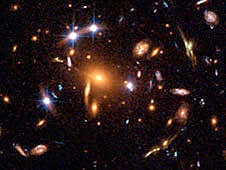 |
| Five starlike images appear when light from a single quasar passes through a gravitational lens. Image credit: Hubble Telescope/NASA |
Topics: Astrophysics, Cosmology, Dark Energy, Dark Matter
For the first 150 million years after the Big Bang, there were no galaxies or stars or planets. The universe was featureless.
As time passed, the first stars formed. Stars collected into galaxies. Galaxies began to cluster together. Those clusters are made up of the galaxies and all the material between the galaxies. Clumps of matter smashed into each other, and the planets in our solar system began to form around the sun.
Something must hold our solar system, galaxies and clusters of galaxies together. And gravity is that "glue."
In some clusters, the space between galaxies is filled with gas so hot, scientists cannot see it using visible light telescopes. The gas only can be seen as X-rays or gamma rays. Scientists look at that gas and measure how much there is between galaxies in clusters. By doing this, they discovered that there must be five times more material in the clusters than we can detect. The invisible matter that we can't detect is called "dark matter."
The Swiss astronomer Fritz Zwicky first used the term "dark matter" in the 1930s. He studied the so-called Coma galaxy cluster and, specifically, how fast it revolves. Clusters are like merry-go-rounds: Their speed of revolution depends on the weight and position of the objects in the clusters, like the weight of the objects and their positions on a merry-go-round. The speed he measured implied the cluster had much more mass than the observable light suggested. *
* NASA: What Is Dark Matter?
Comments